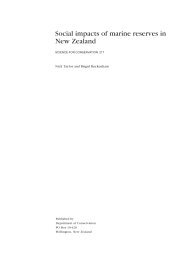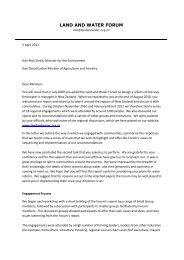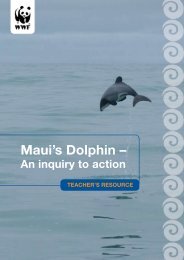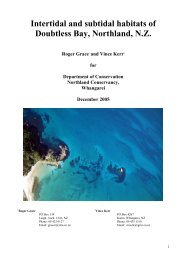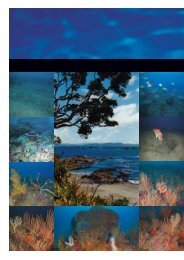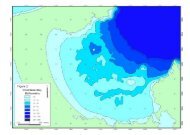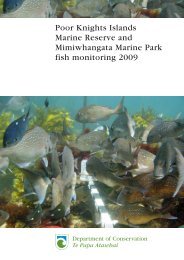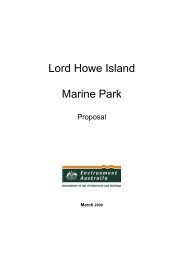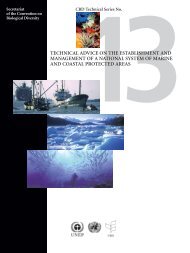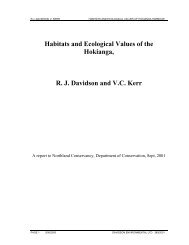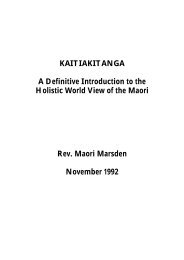WWF Shining a spotlight on the biodiversity of ... - MarineNZ.org.nz
WWF Shining a spotlight on the biodiversity of ... - MarineNZ.org.nz
WWF Shining a spotlight on the biodiversity of ... - MarineNZ.org.nz
Create successful ePaper yourself
Turn your PDF publications into a flip-book with our unique Google optimized e-Paper software.
Seagrasses<br />
c<strong>on</strong>tinued<br />
and producti<strong>on</strong> directly linked to <strong>the</strong> important<br />
roles <strong>the</strong>y play in coastal and estuarine<br />
ecosystems. Recent studies have established<br />
<strong>the</strong> importance <strong>of</strong> New Zealand estuarine<br />
seagrass habitat to benthic macr<strong>of</strong>auna<br />
communities (e.g. Turner et al. 1999, van<br />
Houte-Howes et al., under review) as well<br />
as recreati<strong>on</strong>ally and commercially important<br />
fish species (e.g. Morris<strong>on</strong> and Francis<br />
2001).<br />
Criteria applied:<br />
Species diversity; species richness; dependency<br />
for o<strong>the</strong>r species; trophic/functi<strong>on</strong>al<br />
diversity; c<strong>on</strong>servati<strong>on</strong> status/threat classificati<strong>on</strong><br />
both nati<strong>on</strong>ally and globally; cultural<br />
values; degree <strong>of</strong> disturbance; special c<strong>on</strong>diti<strong>on</strong>s<br />
and specialised <strong>org</strong>anisms; habitat complexity/diversity.<br />
Status and management:<br />
Seagrasses are vulnerable to human impacts<br />
such as changes in sedimentati<strong>on</strong>, coastal<br />
modificati<strong>on</strong>, increased nutrients, and<br />
direct physical disturbance. The 1994 New<br />
Zealand Coastal Policy Statement identifies<br />
<strong>the</strong> protecti<strong>on</strong> <strong>of</strong> areas <strong>of</strong> significant<br />
indigenous vegetati<strong>on</strong> as a nati<strong>on</strong>al priority<br />
for <strong>the</strong> preservati<strong>on</strong> <strong>of</strong> natural character <strong>of</strong><br />
<strong>the</strong> coastal envir<strong>on</strong>ment. Limited areas <strong>of</strong><br />
seagrass currently receive some level <strong>of</strong><br />
protecti<strong>on</strong> (e.g. Whanganui (Westhaven)<br />
Inlet and Te Angiangi marine reserves<br />
include areas <strong>of</strong> seagrass).<br />
State <strong>of</strong> informati<strong>on</strong>:<br />
Informati<strong>on</strong> <strong>on</strong> seagrass in New Zealand is<br />
relatively limited – in particular for permanently<br />
submerged beds. There is some informati<strong>on</strong><br />
<strong>on</strong> <strong>the</strong> physiology and ecology <strong>of</strong><br />
seagrass and some informati<strong>on</strong> <strong>on</strong> associated<br />
biological communities.<br />
References and fur<strong>the</strong>r reading:<br />
Grace and Grace (1976), Inglis (2003), Les<br />
et al. (2002), Morris<strong>on</strong> and Francis (2001),<br />
Ramage and Schiel (1998, 1999), Turner<br />
et al. (1999), Turner and Schwarz (under<br />
review), van Houte-Howes (under review),<br />
Woods and Schiel (1997).<br />
Photic z<strong>on</strong>e rock wall<br />
suspensi<strong>on</strong> feeding<br />
assemblages<br />
Not mapped during<br />
<strong>the</strong> workshop<br />
Locati<strong>on</strong>: Rock wall<br />
assemblages are widespread<br />
in nor<strong>the</strong>ast New Zealand,<br />
<strong>of</strong>fshore islands, and Fiordland.<br />
O<strong>the</strong>r examples al<strong>on</strong>g <strong>the</strong> rest<br />
<strong>of</strong> New Zealand’s coastline<br />
include rock stacks, pinnacles,<br />
and similar formati<strong>on</strong>s.<br />
Approximate area: Not<br />
recorded during <strong>the</strong> workshop<br />
Descripti<strong>on</strong> <strong>of</strong> habitat type:<br />
The photic z<strong>on</strong>e, or <strong>the</strong> depth to which light<br />
penetrates, is up to 200m. Rock walls have a<br />
vertical relief or a very high gradient. They<br />
are typified by str<strong>on</strong>g to moderate currents.<br />
Biological attributes:<br />
Rock walls are home to many ic<strong>on</strong>ic taxa<br />
including black corals, red coral, and<br />
brachiopods. They have a high biomass<br />
and surface cover <strong>of</strong> benthic species and a<br />
high biomass <strong>of</strong> planktivorous fishes. Such<br />
biomass is sustained by energy transfer<br />
from <strong>the</strong> surrounding ocean ecosystem.<br />
The habitat is characterised by very high<br />
feeding up<strong>on</strong> pelagic energy sources – by<br />
benthic/demersal species such as sp<strong>on</strong>ges,<br />
tunicates and/or bryozoans, brachiopods,<br />
hydroids, s<strong>of</strong>t and hard corals, and a variety<br />
<strong>of</strong> planktivorous fishes. The envir<strong>on</strong>ment<br />
is also a carb<strong>on</strong>ate sediment “factory” for<br />
surrounding s<strong>of</strong>t bottoms (Nels<strong>on</strong> et al.<br />
1988).<br />
N<strong>on</strong>-geniculate coralline algae are<br />
particularly important as <strong>the</strong>y cover very<br />
large areas <strong>of</strong> rock walls and are implicated<br />
in invertebrate settlement and recruitment.<br />
Criteria applied:<br />
Species diversity; species richness; endemism;<br />
dependency for o<strong>the</strong>r species; trophic/<br />
functi<strong>on</strong>al diversity; representati<strong>on</strong> (i.e.<br />
across physical types)<br />
Status and management:<br />
Most species are not exploited or directly<br />
threatened. Rock walls have high human<br />
appeal (e.g. for scuba divers). Populati<strong>on</strong>s<br />
are protected in New Zealand’s marine<br />
reserves.<br />
State <strong>of</strong> informati<strong>on</strong>:<br />
Some rock wall sites are very well known,<br />
especially in nor<strong>the</strong>ast New Zealand and<br />
Fiordland. O<strong>the</strong>r sites are <strong>on</strong>ly locally<br />
known. They are best known within SCUBA<br />
range, but o<strong>the</strong>r deeper rock walls are known<br />
to occur.<br />
References and fur<strong>the</strong>r reading:<br />
Battershill and Stocker (1993), Grange<br />
(1986).<br />
Black Coral<br />
BIODIVERSITY – NEW ZEALAND’S MARINE ECOREGION ■ 67<br />
©2004 DOC, Te Papa Atawhai





